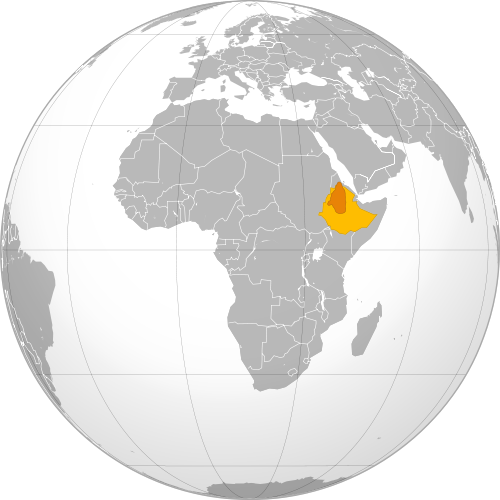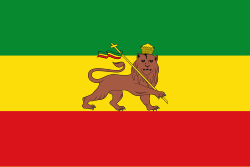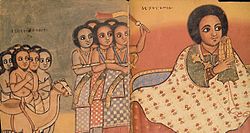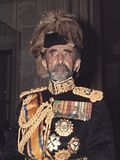Ethiopian Empire
The Ethiopian Empire, or simply Ethiopia, also known as Abyssinia by foreigners, was an empire in East Africa. It used to include modern day Ethiopia and Eritrea. When it was biggest, it controlled some parts of Egypt, Sudan, Yemen, and Saudi Arabia. The official state religion of the empire was Ethiopian Orthodox Christianity.
Ethiopian Empire መንግሥተ ኢትዮጵያ (Ge'ez) <span title="Lua error in package.lua at line 80: module 'Module:Language/data/ISO 639-2' not found. transliteration" class="Unicode" style="white-space:normal; text-decoration: none">Mängəśtä ʾItyop̣p̣ya | |||||||||
|---|---|---|---|---|---|---|---|---|---|
| 1270–1974 1936–1941: Government-in-exile | |||||||||
| Motto: | |||||||||
| Anthem: | |||||||||
 The Ethiopian Empire boundaries in 1952 | |||||||||
 The location of the Ethiopian Empire during the reign of Yohannes IV (dark orange) compared with modern day Ethiopia (orange) | |||||||||
| Capital | Mobile[note 1] (1270–1635) Gondar (1635–1855) Magdala (1855–1868) Mekelle (1871–1889) Addis Ababa (1889–1974) | ||||||||
| Common languages | Amharic (dynastic, official, court)[3][4] Ge’ez (liturgical language, literature) many others | ||||||||
| Religion | State religions: Christianity (Ethiopian Orthodox Church) | ||||||||
| Demonym(s) | Endonym: Ethiopian Exonym: Abyssinian | ||||||||
| Government | Absolute monarchy (1270–1931)[5] Unitary parliamentary constitutional monarchy (1931–1974) | ||||||||
| Emperor | |||||||||
• 1270–1285 (first) | Yekuno Amlak[6] | ||||||||
• 1930–1974 (last) | Haile Selassie | ||||||||
| Prime Minister | |||||||||
• 1909–1927 (first) | Habte Giyorgis | ||||||||
• 1974 (last) | Mikael Imru | ||||||||
| Legislature | None (rule by decree) (until 1931) Parliament (1931–1974)[7] | ||||||||
| Senate (1931–1974) | |||||||||
| Chamber of Deputies (1931–1974) | |||||||||
| Historical era | Middle Ages to Cold War | ||||||||
• | 1270 | ||||||||
• Conquests of Amda Seyon I | 1314–1344 | ||||||||
| 1529–1543 | |||||||||
| 1632–1769 | |||||||||
| 1769–1855 | |||||||||
| 1878–1904 | |||||||||
| 1895–1896 | |||||||||
| 16 July 1931 | |||||||||
• Second Italo-Ethiopian War (annexed into Italian East Africa) | 3 October 1935 | ||||||||
| 5 May 1941 | |||||||||
• | 12 September 1974 | ||||||||
| 21 March 1975[8][9][10][11] | |||||||||
| Area | |||||||||
| 1344 | 1,500,000 km2 (580,000 sq mi) | ||||||||
| 1954 | 1,221,900 km2 (471,800 sq mi) | ||||||||
| Currency |
| ||||||||
| |||||||||
Abyssinia was mentioned in Egyptian records in 980 BC. Its king made the country Christian in the 4th century. The Solomonid dynasty ruled from 1270 to 1974 A.D., when it was overthrown by communists. At the time of its overthrow, it was the longest-lasting government in the world and one of the only two nations that did not get colonized in Africa.
In other languages
Ethiopian Empire:
- Ge'ez Script: የኢትዮጵያ ንጉሠ ነገሥት መንግሥተ, Mängəstä Ityop'p'ya
Ethiopia:
Ethiopian Empire Media
Non-contemporary portrait painting of Emperor Yekuno Amlak from the 17th century
Painting of Emperor Zara Yaqob at his coronation
The Fasil Ghebbi in Gonder
Menelik II at the Battle of Adwa
Haile Selassie with President Lyndon B. Johnson at the White House
Haile Selassie was the last Emperor of the Ethiopian Empire.
Notes
- ↑ The old tradition of the Ethiopian emperors was travelling around the country accompanied by their many courtiers and innumerable soldiers, living off the produce of peasants, and dwelling in temporary encampments. These royal encampments or moving capitals would serve as the headquarters of the empire.[1] Despite this several Ethiopian rulers had attempted to establish fixed capitals such as Tegulet, Emfraz and Debre Birhan.[2]
+{{{1}}}−{{{2}}}
References
- ↑ Pankhurst, Richard (1982). History Of Ethiopian Towns. p. 41. ISBN 9783515032049.
- ↑ Pankhurst, Richard (2009). "Barara, the Royal City of 15th and Early 16th Century (Ethiopia). Medieval and Other Early Settlements Between Wechecha Range and Mt Yerer". Annales d'Éthiopie. 24 (1): 209–249. doi:10.3406/ethio.2009.1394.
- ↑ The Southern Marches of Imperial Ethiopia: Essays in History and Social Anthropology, Donham Donald Donham, Lecturer in Social Anthropology Wendy James, Dr, PhD, Former Senior Lecturer in Mathematics Christopher Clapham, Patrick Manning CUP Archive, Sep 4, 1986, p. 11, https://books.google.com/books?id=dvk8AAAAIAAJ&q=Lisane+amharic#v=snippet&q=Lisane%20amharic&f=false Archived 28 December 2022 at the Wayback Machine
- ↑ Layers of Time: A History of Ethiopia, Paul B. Henze, November 18th 2008, p. 78, https://books.google.com/books?id=3VYBDgAAQBAJ&q=Lisane#v=snippet&q=Lisane&f=false Archived 28 December 2022 at the Wayback Machine
- ↑ Nathaniel T. Kenney (1965). "Ethiopian Adventure". National Geographic. 127: 555.
- ↑ Negash, Tekeste (2006). "The Zagwe Period and the Zenith of Urban Culture in Ethiopia, Ca. 930-1270 Ad". Africa: Rivista Trimestrale di Studi e Documentazione dell'istituto Italiano per l'Africa e l'Oriente. 61 (1): 120–137. JSTOR 40761842.
- ↑ Constitution of Ethiopia, 4 November 1955, Article 76 (source: Constitutions of Nations: Volume I, Africa by Amos Jenkins Peaslee)
- ↑ "Ethiopia Ends 3,000 Year Monarchy". Milwaukee Sentinel: 3. 22 March 1975.
- ↑ "Ethiopia ends old monarchy". The Day: 7. 22 March 1975. https://news.google.com/newspapers?nid=1915&dat=19750322&id=S-sgAAAAIBAJ&pg=2528,3614199.
- ↑ Henc van Maarseveen; Ger van der Tang (1978). Written Constitutions: A Computerized Comparative Study. Brill. p. 47.
- ↑ "Ethiopia". The World Factbook. Central Intelligence Agency. 1987.
- ↑ The Royal Chronicle of his reign is translated in part by Richard K. P. Pankhurst, The Ethiopian Royal Chronicles (Addis Ababa: Oxford University Press, 1967).
- ↑ The Royal Chronicle of his reign is translated in part by Richard K. P. Pankhurst, The Ethiopian Royal Chronicles (Addis Ababa: Oxford University Press, 1967).
- ↑ Markessini, Joan (2012). Around the World of Orthodox Christianity - Five Hundred Million Strong: The Unifying Aesthetic Beauty. Dorrance Publishing. ISBN 9781434914866.
- ↑ Morgan, Giles (2017). St George: The patron saint of England. Oldcastle Books. ISBN 978-1843449676.











